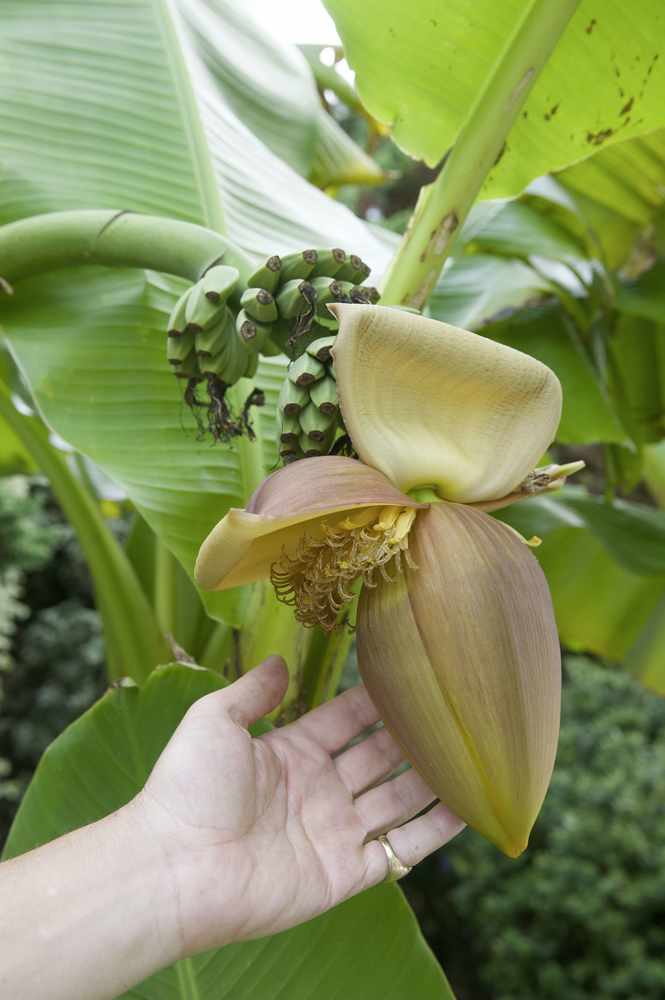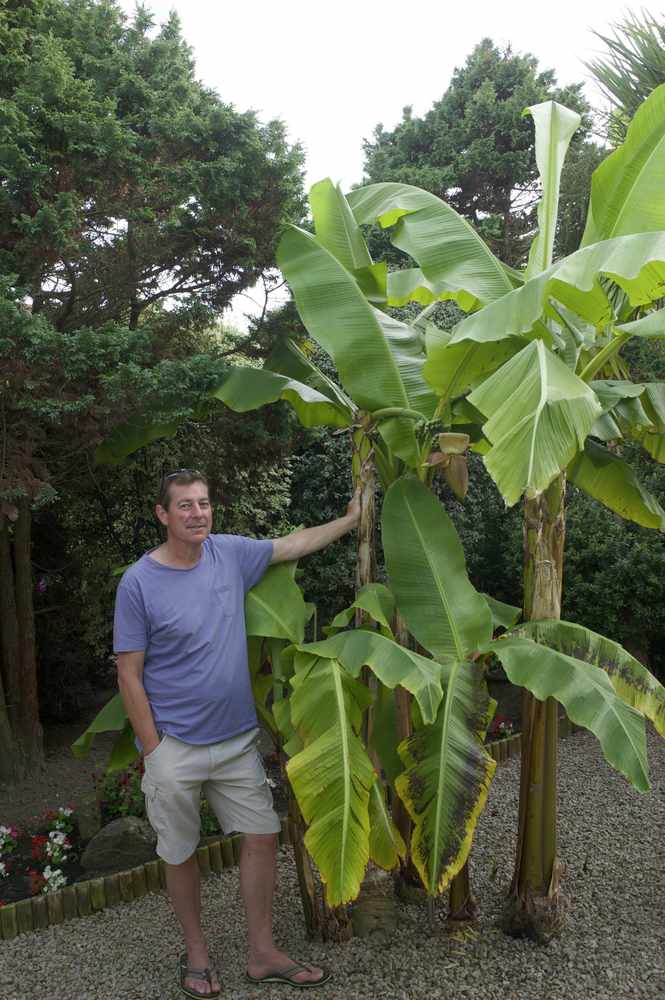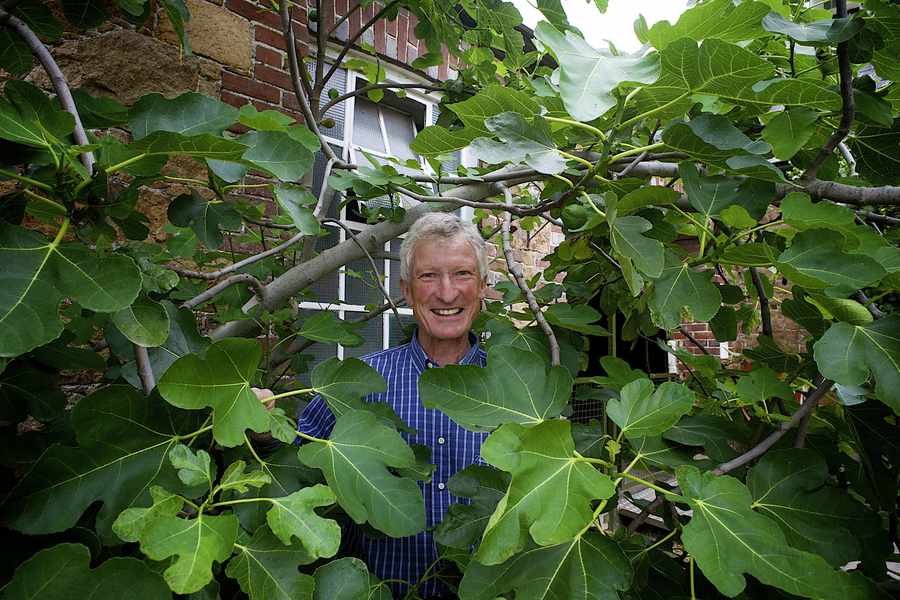- Good soil, mild weather and long hours of sunshine give Jersey the edge when it comes to growing
- Discover the vast range of fruit that people are growing in the Island
- Find out what to do to cultivate your own exotic harvest
- Melons, apricots, figs, pomegranates and bananas can all be found growing in the Island
THE Island’s mild climate, long hours of sunshine, fertile soil and natural protection from frost and harsh winds, creates microclimates where it is possible to grow a variety of plants and fruit indigenous to far warmer climes.
Back in the heyday of ‘bucket and spade’ tourism, when the Channel Islands were the furthest most people travelled outside the UK, the sight of palm trees, ice plants and agapanthus added to Jersey’s continental charms.
Today’s tourists are seasoned travellers but they may still be surprised by the tropical cornucopia of fruit grown behind garden walls, in sheltered corners of residential estates and in grand gardens.
[figure caption=”OVERLOOKING a valley, behind a granite cottage opposite Trinity School is an orchard of almost 200 fruit trees, all planted and cared for by André Militis, who grew up among the forests of south-east Belgium.
What makes his orchard rather special is a row of apricot trees, that in eight years have grown taller than him, and right now are heavy with fruit, the size of supermarket peaches, turning a deep red as they ripen.
And, moreover, he has two lemon trees in his garden, still flowering with sweet-smelling blossom as the fruit grows as big as the average pear, even though he recently cut them back.
Protected from the east, west and north winds and frost, they are thriving as comfortably as they do on the Iberian peninsula.
” title=”Andre Militis growing apricots in Trinity. Picture: JON GUEGAN” align=”right” url=”/?attachment_id=1424593″ id=”1424593″ size=”100″]
Samarès Manor – Turkey (Jersey) fig and pomegranate
SAMARÈS Manor is far more than a tourist attraction for the Seigneur of Samarès, Vincent Obbard, as it is his family garden, which he is happy to share with the public.
Tucked away in a sheltered corner is a pomegranate tree, one of the oldest known fruit, synonymous with the eastern Mediterranean but native to Iran. Mr Obbard said: ‘The fruit is just about ready for eating but only in a very warm summer. I’ve tried to eat them but I would not recommend it.’
The brown Turkey fig, colloquially known as the Jersey fig, produces big fruit whose skin splits when perfectly ripe, exposing the rich purple flesh within.
They were common to Jersey farms in the days of outdoor toilets, before mains drains, when effluent was a good fertilizer for a fig tree, the leaves of which came in useful when the paper ran out.
[figure caption=”THE Payn family have been growing tomatoes in Grouville for over a century and the current incumbent of the farming business, Stanley Payn says they have been growing melons every year for as long as he can remember.
The Island’s (albeit small)
melon industry grew from the once-thriving tomato and tourism industries.
‘Every outdoor tomato grower had a little greenhouse for growing his plants from seed and once they were planted out he would sow a crop of melons for the hotels. This was done in the days when there were tourists everywhere and the hotels gave them a choice of prawn cocktails or melon for a starter,’ he said.
Melons can also be found at
roadside honesty boxes around the countryside in the autumn, but Fauvic Nurseries at Holme Grown is the Island’s only commercial grower producing honeydew, gala and charentais varieties in late summer.” title=”Stanley Payn growing melons at Holme Grown. Picture: JON GUEGAN” align=”right” url=”/?attachment_id=1424591″ id=”1424591″ size=”100″]

IF Simon de Carteret had not kept a tight control on his banana plants, the family home in Causie Lane, St Clement, would resemble a banana plantation.
Unfortunately, edible bananas don’t flourish outside in Jersey but decorative varieties can and do produce a beautiful flower and the beginnings of bunches of fruit, but they must be cut down as they start to rot.
Fortunately, he’s had far greater success growing grapes and last year his vine produced about 300 bunches of juicy black fruit – even though he was told when he bought it as a small plant that it was a white grape. ‘It has turned out to be a black grape which grew so incredibly quickly I had to build a frame to support it,’ he said. ‘I have tried to make wine but it did not work – but they are very good to eat.’
Professional gardener Bernard Rebours says if a garden is located in one of Jersey’s ‘micro growing climates’ – sheltered from frost and chilly winds and preferably south-facing, with good soil and the right varieties, then it is easy to grow apricots, grapes, nectarines, peaches and lemons, as Islanders have done for generations.
He recommends the Moorpark apricot, which was mentioned in Jane Austen’s novel, Mansfield Park, and also one of the earliest-ripening varieties, Tomcot.
When it comes to peaches, Peregrine and Rochester are best suited for the British climate, as is the Lord Napier nectarine.
The ‘Guernsey’ or Cannon Hall grape is ideal for the local climate as is the Muscat variety.
Guernsey had a thriving grape export industry throughout the 19th century, which developed from islanders growing the fruit in lean-to’s against farmhouses and cottages.
At its peak, millions of trays of grapes were exported each year, but production went into decline when growers turned to growing tomatoes.
Mr Rebours recommends the Meyers lemon tree, which can be grown outside in a sheltered position, preferably against a south-facing granite wall, or in a pot and covered and brought in during the winter.
He added that granite walls were a key element in the growing process. ‘The fact that we have lots of granite walls in gardens and around granite farmhouses, and that the old houses all had walled-in gardens, makes a big difference as granite holds the heat and provides a good aspect for growing fruit trees against,’ he said.







